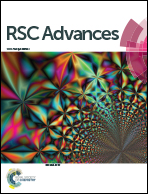Formulation of iron oxide nanoparticles using exopolysaccharide: evaluation of their antibacterial and anticancer activities†
Abstract
In the present study, we report the formulation, characterization, and in vitro antibacterial and cytotoxicity effects of exopolysaccharide (EPS) stabilized iron oxide nanoparticles (FeONPs) against the human epidermoid carcinoma cell line (A431). EPS is extracted from a spore-forming strain of Bacillus subtilis, VT03, isolated from the gut microbiome of the freshwater fish Oreochromis mossambicus (Tilapia). FTIR, 1H NMR and 13C NMR spectroscopic studies show the presence of sugar moieties, confirming that EPS might be a glucan. Later, EPS is used as an eco-friendly reducing and stabilizing agent for the formulation of iron oxide nanoparticles (FeONPs). Initially, the generation of nanoscale FeO was confirmed through the formation of a black-coloured precipitate with an absorbance maxima at 250–300 nm in a UV-visible spectrometer. X-ray diffraction (XRD) planes clearly confirm that the synthesized FeONPs are in the cubic spinel phase. The morphometric features of the synthesized FeONPs are exclusively studied using electron microscopy (FESEM and HRTEM) which shows spherical FeONPs in sizes ranging between 75–120 nm; the mean size was found to be 106 ± 12 nm. Additionally, energy dispersive X-ray analysis (EDAX), selected area emission diffraction (SAED) and dynamic light scattering (DLS) confirms the purity and homogeneity of the synthesized FeONPs. The vibrating sample magnetometer (VSM) technique reveals the presence of both ferro- and antiferromagnetic phases in the EPS-stabilized FeONPs. Further, the inhibitory activity of EPS-stabilized FeONPs against human and fish pathogenic strains such as Aeromonas hydrophila (ATCC 49140), Aeromonas hydrophila (MTCC 1739), Aeromonas sobria (MTCC 3613) and Aeromonas hydrophila (obtained from OIE Reference Laboratory, C. Abdul Hakeem College, Melvisharam) was assessed. The in vitro cytotoxicity effects of free EPS and EPS-stabilized FeONPs were probed in the human epidermoid carcinoma cell line A431. The IC50 values of EPS and EPS-stabilized FeONPs were found to be 350.18 and 62.946 μg ml−1 respectively. Further, acridine orange/ethidium bromide (AO/EtBr) staining of A431 cells at different time intervals clearly distinguishes the live cells and the cells that have undergone apoptotic cell death. In conclusion, our research paves the way for a facile and greener route to synthesize FeONPs at room temperature. On the other hand, this study also proves that the formulated multifunctional hybrid FeONPs have remarkable qualities such as enhanced bioavailability and magnetic properties. This can be developed into a successful theragnostic platform for cancer treatment.


 Please wait while we load your content...
Please wait while we load your content...